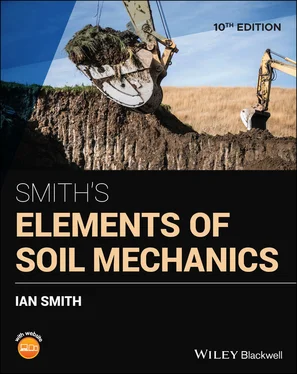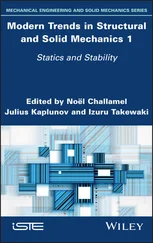1 ...7 8 9 11 12 13 ...29 The structural arrangement of microscopic sized clay particles, or groups of particles, defines the microstructure of a clay deposit. Clay deposits have been laid down under water and were created by the settlement and deposition of clay particles out of suspension. Often during their deposition, the action of Van der Waals forces attracted clay particles together and created flocculant, or honeycombed, structures, which, although still microscopic, are of considerably greater volume than single clay particles. Such groups of clay particles are referred to as clay flocs .
1.4 Field identification of soil
Gravels, sands and peats are easily recognisable, but difficulty arises in deciding when a soil is a fine sand or a coarse silt or when it is a fine silt or a clay. The following rules may, however, help:
| Fine sand |
Silt |
Clay |
| Individual particles visible |
Some particles visible |
No particles visible |
| Exhibits dilatancy |
Exhibits dilatancy |
No dilatancy |
| Easy to crumble and falls off hands when dry |
Easy to crumble and can be dusted off hands when dry |
Hard to crumble and sticks to hands when dry |
| Feels gritty |
Feels rough |
Feels smooth |
| No plasticity |
Some plasticity |
Exhibits plasticity |
The dilatancy test involves moulding a small amount of soil in the palm of the hand; if water is seen to recede when the soil is pressed, then it is either a sand or a silt.
Organic silts and clays are invariably dark grey to blue‐black in colour and give off a characteristic odour, particularly with fresh samples.
The condition of a clay very much depends upon its degree of consolidation . At one extreme, a soft normally consolidated clay can be moulded by the fingers whereas, at the other extreme, a hard overconsolidated clay cannot. Overconsolidation is defined in Section 4.4 and the subject of degree of consolidation is covered in Chapter 13. Guidance on the identification of soils may be found in the international standard for Geotechnical investigation and testing , BS EN IS0 14688‐1 (BSI, 2018a) and in the Code of practice for ground investigations , BS 5930 (BSI, 2015).
In the field, soils are usually found in the form of a mixture of components, e.g. silty clay, sandy silt, etc. Local names are sometimes used for soil types that occur within a particular region. e.g. London clay.
Boulder clay, also referred to as glacial till , is an unstratified and irregular mixture of boulders, cobbles, gravel, sand, silt and clay of glacial origin. In spite of its name, boulder clay is not a pure clay and contains more granular material than clay particles.
Moraines are gravel and sand deposits of glacial origin. Loam is a soft deposit consisting of a mixture of sand, silt and clay in approximately equal quantities.
Fill is soil excavated from a ‘borrow’ area, which is used for filling hollows or for the construction of earth‐fill structures, such as dams or embankments. Fill will sometimes contain man‐made materials such as crushed concrete or bricks from demolished buildings.
Soil classification (see Section 1.6) enables the engineer to assign a soil to one of a limited number of groups, based on the properties and characteristics of the soil. The classification groups are then used as a system of reference for soils. Soils can be classified in the field or in the laboratory. Field techniques are usually based upon visual recognition as described above. Laboratory techniques involve several specialised tests and, in Europe, these are described in different parts of BS EN ISO 17892: Geotechnical investigation and testing – Laboratory testing of soil (BSI, 2014–2019). In much of North America and some other nations, specification D2487‐17, published by ASTM International, is used. The procedures are largely the same across all the testing standards.
1.5 Soil classification laboratory testing
1.5.1 Drying soils
Soils can be either oven or air dried. It is standard practice to oven dry soils at a temperature of 105 °C but it should be remembered that some soils can be damaged by such a temperature. Oven drying is necessary for water content, sieve analysis and a few other tests, but air drying can be used whenever a test does not require a fully dry sample, e.g. compaction tests, described in Chapter 15.
1.5.2 Determination of water content, w
The most common way of expressing the amount of water present in a soil is the water content . The water content, also called the moisture content , is given the symbol w and is the ratio of the amount of water to the amount of dry soil.
(1.1) 
w is usually expressed as a percentage and should be quoted to two significant figures.
Example 1.1 Water content determination
A sample of soil was placed in a water content tin of mass 19.52 g. The combined mass of the soil and the tin was 48.27 g. After oven drying the soil and the tin had a mass of 42.31 g.
Determine the water content of the soil.
Solution:

1.5.3 Granular soils – particle size distribution
A standardised system helps to ensure consistency between engineers in the classification of granular soils. The usual method is based on the determination of the particle size distribution (PSD) by shaking an oven dried sample of the soil (usually after washing the sample over a 63 μm sieve) through a set of sieves. The aperture size of each succeeding sieve is smaller than the one above. By weighing the mass of soil retained on each sieve, we can obtain the particle size distribution for the soil.
The particle size scale is based on the limits for each fraction listed in Table 1.1.
Table 1.1 Particle size limits for different soil fractions.
| Particle size fractions and symbol |
Upper size (mm) |
Lower size (mm) |
| Gravel, Gr |
60 |
2 |
| Sand, Sa |
2 |
0.06 |
| Silt, Si |
0.06 |
0.002 |
| Clay, Cl |
0.002 |
– |
These fractions can be subdivided on the basis of the 6‐2, 6‐2 pattern:
e.g. gravel:coarse, c: 60–20 mmmedium, m: 20–6 mmfine, f: 6–2 mm.
Similar subdivisions can be made for sand and silt.The symbols are combined to aid classification, e.g.
cGr – coarse gravel; fSa – fine sand; mSi – medium silt.
The particle size fractions listed above refer to the classification system adopted in Europe, see also BS EN ISO 14688‐1:2018 (BSI, 2018a). ASTM International standard D2487‐17 (2017) offers an alternative system ( United Soil Classification System, USCS ) which adopts different sizes as the boundaries between the particle size fractions.
The results of the sieve analysis are plotted with the particle sizes horizontal and the summation percentages vertical. As soil particles vary in size from molecular to boulder it is necessary to use a log scale for the horizontal plot so that the full range can be shown on the one sheet.
Читать дальше














